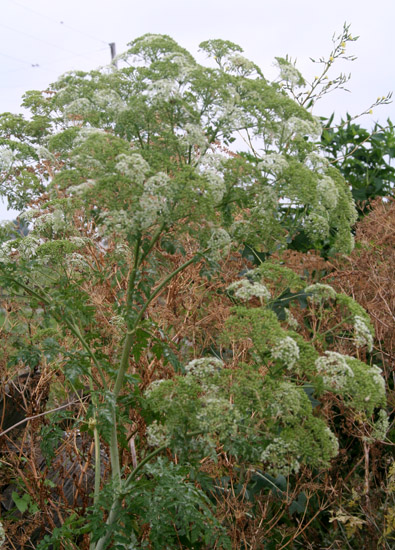Issue 7, June 5, 2012
Poison Hemlock - Beautifully Poisonous
6/6/12 Revision - It has been noted that the leaves are in fact alternately arranged. The deeply dissected leaflets are opposite, but the overall leaf is alternate. The article has been corrected to reflect this fact.
The ditches and roadsides of Central Illinois are showy right now with the white flowers of Poison hemlock (Conium maculatum). This plant is found statewide however in dense stands, and has been in greater abundance in recent years earning a spot on both a factsheet and a poster featuring exotic, invasive plants in Illinois habitats. This biennial is native to Europe, Western Asia, and Northern Africa and is commonly found in disturbed soils, pastures, meadows, roadsides, and along pond edges. Poison hemlock tends to prefer moist soils but can tolerate drier sites; it grows well in full sun or part shade.

Poison Hemlock
This herbaceous plant starts off as a basal rosette of leaves the first year. In year two, it grows large quickly, developing an erect, branched stem that can reach up to 10 feet. The leaves are shiny, 8 to 16" long and alternately arranged. They are pinnately compound (somewhat fern-like) with fine serrations along the margins. The leaves have an unpleasant smell when bruised.
The stems are smooth, thick, and ribbed. Look for the purple speckles or spots when identifying this plant. The stems are also hollow between the nodes. The underground portion consists of a fleshy taproot. This plant spreads by seed and the seed stalks persist throughout the winter.
A related species is wild carrot or Queen Anne's lace, whose flowers are also white yet much larger at 3 to 6.5 inches in diameter. The flower heads (umbrella shaped) of poison hemlock are only 1.5 to 2.5 inches across. Each flower has 5 small petals. The leaves of wild carrot have a much more pleasant carrot scent and the stems are hairy.
The entire plant of poison hemlock is very poisonous, containing toxic alkaloids that cause respiratory failure when ingested. It is reported that Socrates was killed in 399 B.C. with an extract of poison hemlock. Also reported are birth defects found in livestock. The weed can irritate the skin so proper care should be taken to either avoid handling this plant or wear adequate clothing such as long sleeves and gloves to cover the skin.
Poison hemlock can be controlled mechanically by digging or tilling. Repeated mowing is also effective. Herbicides such as 2,4-D and glyphosate can be applied in early spring or late fall. As always, carefully read and follow all label directions. (Michelle Wiesbrook)
Author:
Michelle Wiesbrook